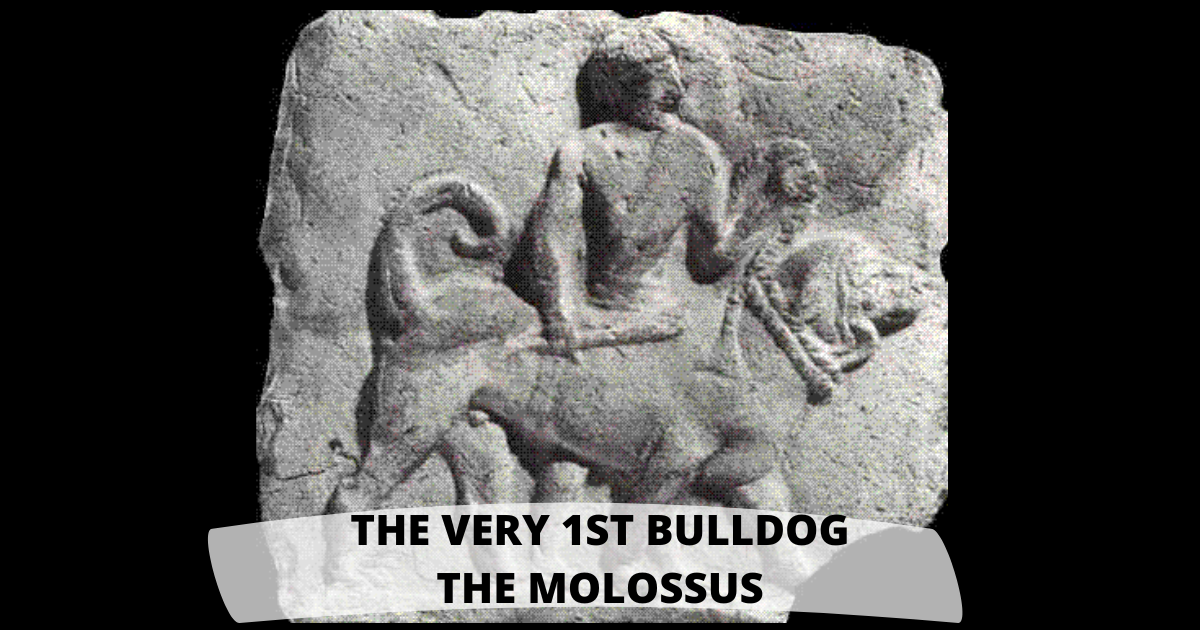The beginnings of the incredible Bulldog start with ancient Greece. An ancient Greek tribe, also known as the Molossians, inhabited the region of Epirus. They bred massive dogs for war and work, known as the ‘Molossus.’
The Molossus became incredibly popular throughout the world during the Hellenic period. A while later in 347 B.C., Aristotle recognized the Molossus breed as a type of dog rather than its own singular breed. He described two different dogs, one that was suggested to be a guardian dog for livestock, and another that was a coursing dog. This information may describe why the descriptions of the Molossus dog can be either vague or different from one another.
The Molossus appearance

The appearance of Molossus is largely unclear. Legends say the Molossus was a very large, powerful, and muscular dog with thick legs and a wide chest. Some say that the Molossus was more of a sighthound type of dog with straight, tall legs and long ears. Some describe them as very generic looking and medium-sized dogs that could vary in appearance. So, no one exactly knows what the Molossus dog looked like.
Interesting facts about the Molossus
Let’s have a look at some fun facts about the Molossus:
- The Molossus was frequently mentioned in ancient literature, including the writings of Aristotle, Aristophanes, Grattius, Lucan, Horace, Lucretius, Martial, Nemesianus, Oppian of Apamea, Seneca,, Plautus, Statius, Ovid, and Virgil.
- The Molossians issued silver coinage with an image of a Molossus dog as their emblem.
- Many books and magazines in Continental Europe and North America states that all mastiff-type dog breeds are descended from the Molossus.
- Other names of Molossus are Mastín, Dogge, Dogue, Μολοσσός, and Molossian hound.
- About 80 years after the Greco-Roman war, in 411 B.C., a play referenced a Molossian dog.
- The Molossus were recognized as fierce, ferocious, and loyal dogs. They were bred for distinct tasks rather than as a companion dog. Molossus were used as war dogs, guard dogs, hunting dogs, herding dogs and were trained to fight to the death.
- The Molossus were highly energetic and had a lot of stamina. They required an immense amount of daily exercise.
- In Greek mythology, the goddess Artemis gave Procris a dog, Laelaps, that never failed to catch its prey. Molossian and Laconian hounds derived from this dog.
In the 2nd Century A.D., the Molossus started to lose prominence with the collapse of the Roman Empire. They were bred with other dogs and became different from the original Molossus dog. Now there are many Kennel Clubs which include Mastiff and bully-like breeds. Today, the Molossus is not just a dog but rather a category that other dog breeds are a part of.
Origin of bully breeds
Bully breeds are descended from this extinct large breed of dog, Molossus. Exported to Asia and Northern Africa, the Molossus was interbred with dogs of the regions. That resulted in offspring with shorter coats while retaining the characteristics of massive heads and short muzzles.
Eventually, these dogs made their way to the British Isles, where they were bred with Celtic tribe dogs. The resulting dogs were trained to grab a horse by its nose during battle. Through selective breeding, the bully breed/ Bulldog breed gradually evolved and became a separate breed from the Molossus.
The following are Molossus descendants, known as the Bully Breeds or Bulldog Breeds:
- Alapaha Blue Blood Bulldog
- American Staffordshire Terrier
- American Mastiff
- American Bulldog
- American Pit Bull Terrier
- Bandog
- Belgian Mastiff
- Boxer
- Boerboel
- Boston Terrier
- Staffordshire Bull Terrier
- Bull Terrier
- Dogue De Bordeux
- Bulldog
- Bullmastiff
- Cane Corso
- Dogo Argentino
- Olde English Bulldogge
- English Mastiff
- French Bulldog
- Great Dane
- Neapolitian Mastiff
- Pug
- Perro de Presa
- Renascence Bulldogge
- Victorian Bulldog
- Rottweiler
Final thoughts
The Molossus were quite famous throughout the ancient world for their impressive size and ferocity. Regardless of the origins, the Bully has now become a gentle breed beloved by pet parents around the world who treasure their affectionate nature. They make loving, gentle, and trustworthy family dogs and offer great companionship throughout their life.

